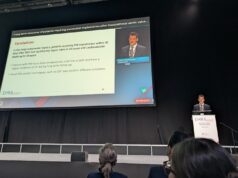A study published in the Journal of the American Medical Association has found that an invasive strategy of systematic electrophysiology study and prophylactic pacemaker implantation in patients with myotonic dystrophy type one and major infranodal conduction delays was associated with a higher rate of nine-year survival than a non-invasive strategy.
Sudden death is the cause of death in up to one third of patients with myotonic dystrophy type one, and the American College of Cardiology (ACC) recommends permanent pacing in patients with this condition if they have complete atrioventricular block or advanced high-degree atrioventricular block with a class I indication. The ACC also recommends prophylactic pacing, with a class IIb indication, in patients with first-degree atrioventricular or fascicular block.
However, lead author Karim Wahbi, department of Cardiology, Cochin Hospital, Paris, France, and co-authors reported: “The benefit associated with prophylactic pacing for the prevention of sudden death has never been confirmed by the results of a clinical study.” Therefore, the aim of their study was to “determine the overall survival rates of patients presenting with conduction abnormalities on the electrocardiogram and managed with a non-invasive strategy and regular surveillance compared with patients managed with an invasive strategy.”
Wahbi et al conducted a retrospective review of patients from the DM1 (myotonic dystrophy type 1) Heart Registry. They excluded recipients of a pacemaker device implanted before their inclusion in the registry and those who presented with a high-degree atrioventricular or sinus node dysfunction (and therefore, had a class I indication for a pacemaker). Patients were split into two groups: the invasive strategy group, who underwent a systematic electrophysiology study and prophylactic permanent pacing if the HV interval was greater than 70ms; the non-invasive strategy group, who did not undergo electrophysiology study and were not implanted with a pacemaker.
Of the 486 patients in the study who were eligible for the retrospective review, 341 were put in the invasive group and 145 were put in the non-invasive group. Overall, after nine years of follow-up, 80 patients had died and the majority (50) of these were patients in the invasive group at the time. However, Wahbi et al reported: “Survival in the invasive strategy group was consistently higher than in the non-invasive group.” They added that after adjusting for age, sex, and other variables (such as QRS duration), the hazard of dying in the invasive strategy group was nearly 40% lower than the hazard of dying the non-invasive strategy. Additionally, the hazard of dying suddenly 75% was lower in the invasive group compared with the non-invasive group. There were no significant differences between the groups in terms of respiratory death or in terms of mortality from other causes.
According to Wahbi et al, another study by Groh et al did not find a correlation between pacemaker implantation (for prophylactic pacing or for high-degree atrioventricular block) and total mortality. They wrote: “However, that study was designed to identify predictors of sudden death and not to specifically ascertain the impact of permanent pacing on morality.” They added that that the design of their study had several advantages compared with Grob et al‘s study, including the higher proportion of patients who underwent the invasive strategy.
Wahbi told Cardiac Rhythm News: “Ideally, a randomised controlled trial should be performed to confirm these results. However, regarding the major impact of the invasive strategy on sudden death, I wonder if such a study would be considered as ethical and accepted by an ethical committee. An ongoing Italian study, RAMYD, will provide interesting additional information on sudden death prevention in myotonic dystrophy type one. This is a prospective cohort study that has a large population of patients with myotonic dystrophy type one, which is assessing the incidence of sudden death in patients managed according to a strategy that is very similar to our study. It will be interesting to compare the incidence of sudden death in their patient population and in patients from our invasive strategy group.”












